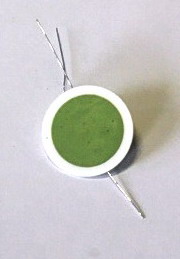
Avaliable methods of research
- TOF SIMS
- Thermogravimetric and differential thermal analysis
- Impedance
- Testing of SOFC stacks
- Power electronics
- XPS
- Clean room for MEA production
- Bipolar plate production and tests
- SOFC tests
Time Of Flight Secondary Ion Mass Spectroscopy (TOF SIMS)
Most of the emitted particles are neutral in charge, but a small proportion is also positively or negatively charged. The subsequent mass analysis of the emitted ions provides detailed information on the elemental and molecular composition of the surface.
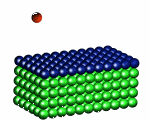
SIMS is a very surface sensitive technique because the emitted particles
originate from the uppermost one or two monolayers. The dimensions of the
collision cascade are rather small and the particles are emitted within an area
of a few nm in diameter. Hence, SIMS can be used for micro analysis with very
high lateral resolution, provided that such finely focused primary ion beams can
be formed.
SIMS is destructive in nature because particles are removed from the surface.
This can be used to erode the solid in a controlled manner to obtain information
on the in-depth distribution of elements. This dynamic SIMS mode is widely
applied to analyse thin films, layer structures and dopant profiles. In order to
receive chemical information on the original undamaged surface, the primary ion
dose density must be kept low enough (< 1013 cm-2) to
prevent a surface area from being hit more than once. This so-called static SIMS
mode is widely used for the characterisation of molecular surfaces.
Most of the emitted particles are neutral in charge. Post-Ionisation of these
particles by electrons, plasma or photons allows mass analysis of these
particles. This technique is called Secondary Neutral Mass Spectrometry, SNMS.
One of the most efficient ways to ionise the emitted neutrals is Laser
Post-Ionisation (Laser-SNMS). This technique is becoming very attractive for the
quantitative analysis of extremely small volumes.
Time of Flight
TOF mass spectrometry is based on the fact
that ions with the same energy but different masses travel with different
velocities. Basically, ions formed by a short ionisation event are accelerated by an electrostatic field to a common
energy and travel over a drift path to the detector. The lighter ones arrive
before the heavier ones and a mass spectrum is recorded. Measuring the flight
time for each ion allows the determination of its mass.
This cycle is repeated with a repetition rate which depends on the flight time
of the highest mass to
be recorded.
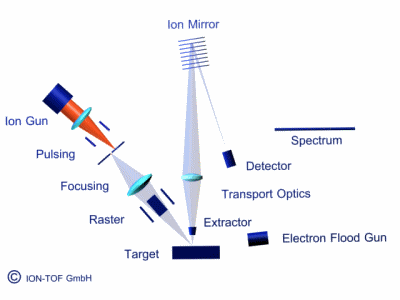
In a more sophisticated design, the TOF analyser corrects for small differences
in initial energy and angle in order to achieve high mass resolution.
Combinations of linear drift paths and electrostatic sectors or ion mirrors are
used and results with mass resolutions, M/dM, above 10,000 can be achieved.
Major advantages of this approach over quadrupole and magnetic sector type
analysers are the extremely high transmission, the parallel detection of all
masses and the unlimited mass range.
In TOF-SIMS, a start time of all secondary ions is defined by using a pulsed
primary ion beam. Extremely short ion pulses with a duration below
1 nanosecond are applied for high mass resolution analysis. These ion pulses are
formed from a continuous beam by a pulsing unit and can be compressed in time by
electro-dynamic fields (Bunching).
The pulsed beam can be focussed to a small spot (Ion Microprobe) to address a
small area of interest and can be rastered to determine the lateral distribution
of elements and molecules (Imaging SIMS).
During the drift time of the secondary ions, the extraction field is switched
off and low energy electrons are used to compensate for any surface charging
caused by primary or secondary particles (Charge Compensation). Thus all types
of bulk insulators can be analysed without any problems.
The time during which the extraction field is switched off can also be used to
apply low energy ion beams for sample erosion. In this case the low energy beam
forms a sputter crater, the centre of which is analysed by the pulsed beam (Dual
Beam Mode).
For the analysis of the sputtered neutrals, pulsed laser beams can be used. The
cloud of neutral particles above the surface desorbed by the pulsed primary ion
beam are ionised by very intense laser radiation (Laser post-ionisation). In
doing so, the high number of neutrals also being desorbed by the primary ion
pulse, become accessible for mass analysis and therefore increase the
sensitivity for elemental species.
Surface Imaging
By rastering a fine-focussed ion beam over the surface, like an electron beam in an electron microprobe, mass resolved secondary ion images (chemical maps) can be obtained simultaneously.- High lateral resolution (<60 nm)
- Fast image acquisition (up to 50 kHz pixel frequency)
- Field of view from Ám2 to cm2
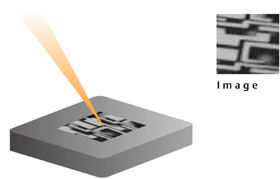
Depth Profiling
For Depth Profiling two ion beams operate in the Dual Beam Mode. While the first beam is sputtering a crater, the second beam is progressively analysing the crater bottom.- Depth resolution better than 1 nm
- High mass resolution
- Sputter speed of up to 10 Ám/h
- Ideally suited for insulators
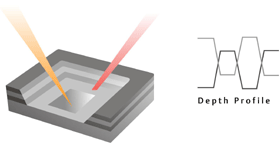
corresponding links: http://www.iontof.com/
russian distributor: http://eng.technoinfo.ru/
... top



